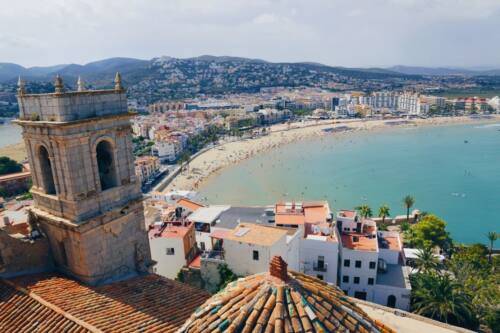##On the Costa del Azahar, the ‘orange blossom coast’ in the north of the Valencia region between Castellón and the Ebro, you’ll find the seaside town of Peñiscola. It’s a Spanish coastal town much like any other, built around the remnants of a quaint old fishing village with its five kilometres of beaches, its EU blue flag, its ‘international’ pizza, paella, pasta or pork chops restaurants, crazy golf courses and night spots.
But this isn’t just any old seaside resort. What sets Peñiscola apart is its spectacular, steep-walled old town and medieval castle, which jut out from the mainland forming a rocky peninsula. This is ‘the City in the Sea’ surrounded by the Mediterranean on three sides and connected to its modern-day ‘seven nights half-board, happy hour and beach aerobics’ self by just a narrow strip of land.
Hannibal and Jaime I stayed here, it was a home of Templar knights and a pope, a place where saints were martyred, the backdrop of an epic Hollywood movie and wildly popular television programme and not a bad place to go for a springtime trip up the coast.
Peñiscola has been inhabited over the centuries by Phoenicians, Greeks, Carthaginians, Romans, Visigoths, Muslims and Christians, each attracted to the natural fortress formed by this rocky headland. It was here well over 2,000 years ago that Hannibal made a sworn oath of hatred against Rome to his father Hamilcar Barca, the man who gave his name to Barcelona. Some years later, Hannibal packed his trunk and an army of his fellow Carthaginians and went off to sack the Eternal City.
The Muslim rulers of Valencia had a garrison fortress at Peñiscola for three centuries until it was eventually captured by Christian King Jaime I. He ceded the town to enigmatic Order of the Knights Templar who built the castle and citadel, which can be seen today, in the style of the architecture they had seen during the Crusades in the Holy Land. The mysterious Templars got a bit too powerful for their own good and fell from grace after the final defeat of the Crusades…they were accused of heresy and many of them were burnt at the stake. There is a permanent Knights Templar exhibition in the castle.
Peñiscola then fell into the hands of the Vatican and could have remained so, as a sort of pontific version of Gibraltar without the monkeys and the nuclear submarines, had Alfonso V not swapped it back for some land in the Kingdom of Naples.
But the name that is most associated with Peñiscola is that of Pedro de Luna, an Aragonese nobleman who was made Pope Benedict XIII or ‘Papa Luna’ in Avignon in 1394. Because of the Great Schism in the Western Catholic church, between 1409 and 1417 there were three men claiming to be pope… one in Rome, Papa Luna in Avignon and a third pope who had been elected to replace the other two in an attempt to solve the problem.
When an agreement was finally reached and a fourth man was elected and recognized as pope, Papa Luna refused to accept this and moved back to Aragon to the castle of Peñiscola (presumably thinking, “That’ll show them!”) where he lived until he was 95 years old, still considering himself the pope and making papal statements and maintaining a council of ‘cardinals’ while being largely ignored by the outside world.
This forgotten and some might say rather deluded man left his mark. All squashed into the somewhat less than Vatican size castle of Peñiscola you can find the grandly named Hall of the Conclave, the basilica of the Virgin Mary and the Magi and the pontific halls.
That wasn’t the end of it for Peñiscola; Hollywood was to leave its own legacy. The old castle was restored and ramparts looking out to the sea were built for Anthony Mann’s 1960 film “El Cid”. Charlton Heston and Sophia Loren strolled around Peñiscola’s Patio de Armas and looked out over the fake ramparts as the town played the part of the city of Valencia, which was already becoming too built up and was also considered to be “too far away from the sea” to play itself. The local council rather liked the look of Mann’s ramparts and there they remain.
In more recent years, Peñiscola has made it to the international small screen as well, playing the part of the fictional Meereen in the sixth season of ‘Game of Thrones’. Much of the city is gigantic CGI pyramids, but in other shots characters such as Tyrion Lannister and Lord Varys walk through the Paseo de Ronda, Plaza Santa María, Rampa Felipe II and Parque de Artillería. The new attention inspired Peñiscola’s tourism office to create a new tour, Peñiscola de Cine, to help fans of various films and TV shows explore set locations.
Peñiscola’s connection with the cinema continues with the annual comedy film festival, which attracts both national and foreign actors and directors. The town has a special connection with comedy, as it was the location of Luis Berlanga’s classic comedy ‘Calabuch’.
The castle has influenced this seaside town as much as the tourists have influenced the castle. Consequently you’ll find that nearly every house in the old town’s ancient, sinuous, winding streets seems to be a restaurant or a souvenir shop. But that, you might say, is part of its charm. If you want to combine a bit of history with your sun, sea and sangria then Peñiscola is well worth a visit.
David Rhead and José Marín
[Additional research by Rachel McClamroch]
Related Post
This site uses Akismet to reduce spam. Learn how your comment data is processed.

























Leave a comment